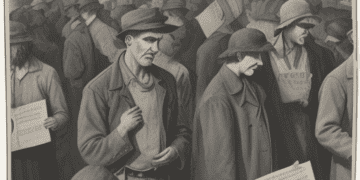The Great Depression stands as an unparalleled economic downturn that unfolded between 1929 and 1941, coinciding with the United States’ entry into World War II. This era was marked by numerous economic setbacks, notably the stock market crash of 1929 and subsequent banking crises in 1930 and 1931.
Economists and historians widely regard the Great Depression as one of the most significant economic crises of the 20th century due to its enduring impact on global economies.
Key Points to Consider The Great Depression spanned from 1929 to 1941, featuring a sequence of severe economic contractions. The crash of the stock market in 1929, coupled with subsequent banking crises, resulted in substantial loss of nominal wealth, triggering a deep economic downturn. However, consensus among experts indicates that the stock market crash alone wasn’t the sole cause of the Great Depression; other factors, including Federal Reserve actions and governmental responses, played contributing roles.
Ending the Depression Conventional wisdom credits the termination of the Great Depression to New Deal job initiatives and substantial government investments leading up to World War II. However, diverging perspectives contest this view, suggesting that lesser government intervention might have concluded the depression earlier.
Stock Market Crash and Economic Ripples The period leading to the 1929 crash witnessed a speculative surge in both real estate and the New York Stock Exchange. Loose monetary policies and extensive margin trading fueled a drastic rise in asset prices, ultimately culminating in the crash.
The crash’s aftermath brought about widespread financial crises beyond the U.S., impacting Europe significantly. The economy nosedived, with unemployment soaring from 3.2% in early 1929 to over 25% by 1933.
Federal Reserve’s Role and Mismanagement The Federal Reserve’s management of money supply and credit before and after the crash faced criticism from economists. Some argue that its actions fueled the market’s rapid expansion before the collapse and exacerbated the situation by drastically reducing the money supply afterward.
Mistakes made by the Federal Reserve were instrumental in aggravating the economic situation during the Great Depression, with their tight monetary policies further deepening the crisis.
Presidential Interventions Both Presidents Hoover and Roosevelt implemented various policies to alleviate the depression’s impact. Hoover’s efforts included increased federal spending and price control measures, while Roosevelt’s New Deal introduced innovative programs aiming to stabilize the economy.
The New Deal’s Impact and Controversy The New Deal, a series of government programs designed to revive the economy, brought about significant reforms but also generated debate among economists. While it led to financial system stabilization, some argue that its extent hindered a swifter recovery.
Impact of World War II The entry of the United States into World War II marked a turning point, coinciding with a decrease in unemployment rates. However, the war effort also led to significant economic disruptions.
Conclusion The Great Depression stemmed from a combination of factors, including governmental and Federal Reserve actions. Its repercussions spurred significant reforms that continue to influence economic policies to this day.
Understanding the complexities and lessons of the Great Depression remains crucial in shaping modern economic strategies, acknowledging the enduring legacy left by this historic period.
Get the latest supply chain report news insights at The Supply Chain Report. For international trade resources, visit ADAMftd.com.
#GreatDepression #StockMarketCrash #FederalReserve #NewDeal #WWIIEconomy #EconomicHistory #GlobalImpact #FinancialCrisis

















